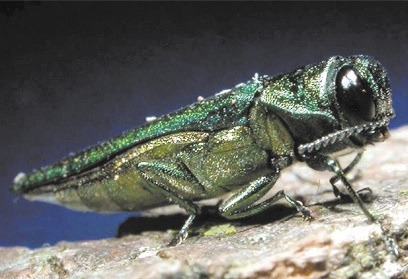AUGUSTA – If you happen to be walking in the woods and notice a purple, box-like kite up in the branches of an ash tree, leave it alone.
The purple corrugated plastic folded into a prism shape is a trap to lure a small invasive beetle from Asia. The flying bugs, emerald ash borers, arrived in the United States about a decade ago and have the potential to devastate Maine’s ash trees — although they haven’t been detected here yet.
The bugs are attracted to the color and scent of the trap, which is covered in sticky manuka oil and a leaf-blended compound.
Maine is involved in a national project designed to monitor the invasive progress of the emerald ash borer, which has destroyed millions of acres of trees in 15 other states and Canadian provinces.
During a news conference Thursday at the Maine Forest Service Bolton Hill Facility in Augusta, entomologist Colleen Teerling demonstrated how the more than 900 bug traps will be placed in trees throughout the state, by stringing a trap high up in a young ash tree behind the facility.
“This trap will stay through the summer, and we’ll check to see if there’s any beetles attached to it,” Teerling said. “At the end of summer, we’ll take the trap off the tree.”
It is a collaborative effort of the U.S. Department of Agriculture Animal and Plant Health Inspection Service; the Maine Department of Agriculture; the Maine Forest Service, under the Maine Department of Conservation; and the Penobscot Nation’s Department of Natural Resources.
Terry Bourgoin, USDA state health director of the plant protection and quarantine, said the beetle was first detected in the United States in 2002 in Michigan. He said it came to America on wooden packing material from Asia, probably in the late 1990s, and has spread since then.
“This is an infestation we want to find early,” Bourgoin said. “It’s not only a problem for forests, but also cities and towns.”
An infestation of the Asian beetle also would be a problem for tourism, according to Rick Abare of the Maine Campground Association. He said people who come to Maine to enjoy its forests are more likely to return and bring their children than those who visit the coastal areas.
“Tourists love our forests,” Abare said. “Tourism brings in millions of dollars in revenue and supports 110,000 jobs. Obviously, it’s very important to us.”
Tourism is Maine’s largest industry, with $10 billion in sales, according to data from the UMaine Cooperative Extension.
“We have to try and keep (the insect) from taking over our forests,” said Maine Agriculture Commissioner Walt Whitcomb.
Ash is one of Maine’s most valuable timber trees. It is used for products ranging from baseball bats and kitchen cabinets to American Indian baskets.
Bourgoin said public awareness is key to locating the beetle. He said his department has received hundreds of calls from people on the lookout for infested trees.
The emerald ash borer larvae are creamy white with bell-shaped segments. The adult beetles are metallic green with a coppery red abdomen.
They are about a half-inch long and slender. The wood-boring insect lays its eggs and develops to maturity under the bark of ash trees. Many ash trees die within three years of being infested.
Bourgoin said his department is covering the cost of the traps, which cost $90 each. Unfortunately, he said, there will be little federal funding in the future.
Officials asked that suspected beetle findings are reported to Teerling at 287-2431 or (800) 367-0223.
Morning Sentinel Staff Writer Mechele Cooper can be contacted at 621-5663 or at:
mcooper@centralmaine.com
Copy the Story Link
Send questions/comments to the editors.



Success. Please wait for the page to reload. If the page does not reload within 5 seconds, please refresh the page.
Enter your email and password to access comments.
Hi, to comment on stories you must . This profile is in addition to your subscription and website login.
Already have a commenting profile? .
Invalid username/password.
Please check your email to confirm and complete your registration.
Only subscribers are eligible to post comments. Please subscribe or login first for digital access. Here’s why.
Use the form below to reset your password. When you've submitted your account email, we will send an email with a reset code.